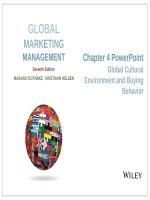Lecture Global marketing management (7th edition): Chapter 11 - Masaaki Kotabe, Kristiaan Helsen
Bạn đang xem bản rút gọn của tài liệu. Xem và tải ngay bản đầy đủ của tài liệu tại đây (4.49 MB, 28 trang )
GLOBAL
MARKETING
MANAGEMENT
Seventh Edition
MASAAKI KOTABKE | KRISTIAAN HELSEN
Chapter 11 PowerPoint
Global Product Policy
Decisions II:
Marketing Products and
Services
Chapter Overview
1. Global Branding Strategies
2. Management of Multinational Product Lines
3. Product Piracy
4. Country-of-Origin (COO) Effects
5. Global Marketing of Services
Chapter 11
Copyright © 2017 John Wiley & Sons,
Inc.
2
Introduction
• Companies that brand their products have various
options when they sell their goods in multiple
countries.
• More and more companies see global (or at least
regional) branding as a must.
Chapter 11
Copyright © 2017 John Wiley & Sons,
Inc.
3
Introduction
• Multinational product line management entails
issues such as:
– What product assortment should the company launch
when it first enters a new market?
– How should the firm expand its multinational product
line over time?
– What product lines should be added or dropped?
• Global marketers also face the issue of global
piracy.
• In global marketing, firms have to use a multitude of
strategies to handle the negative country-of-origin
stereotypes.
Chapter 11
Copyright © 2017 John Wiley & Sons,
Inc.
4
1. Global Branding Strategies
• Global Brands (Exhibit 11-1)
– A truly global brand is one that has a consistent
identity with consumers across the world.
– The development costs for products launched under
the global brand name can be spread over large
volumes.
– A global brand has much more visibility than a local
brand.
– The fact of being global adds to the image of a brand
country.
Chapter 11
Copyright © 2017 John Wiley & Sons,
Inc.
5
Exhibit 11-1: World’s Top 20 Most Valuable
Brands (2012)
Chapter 11
Copyright © 2017 John Wiley & Sons,
Inc.
6
1. Global Branding Strategies
– Global brands are also able to leverage the country
association for the product.
– The value of a global brand (brand equity) usually
varies a great deal from country to country (three key
value dimensions: quality signal, global myth, and
social responsibility).
– Inter-country gaps in brand equity may be due to any
following factors:
•
•
•
•
•
Chapter 11
History
Competitive climate
Marketing support
Cultural receptivity to brands
Product category penetration
Copyright © 2017 John Wiley & Sons,
Inc.
7
1. Global Branding Strategies
• Local Branding
– Example: Coca Cola owns numerous local and
regional brands across the globe such as Thums Up
in India
• Global or Local Branding?
– Solo branding, hallmark branding, family branding,
and extension branding.
– A firm’s global brand is shaped by three types of
factors:
• Firm-based drivers
• Product-market drivers
• Market dynamics
Chapter 11
Copyright © 2017 John Wiley & Sons,
Inc.
8
Exhibit 11-2: Ab-Inbev’s Local Champions
Chapter 11
Copyright © 2017 John Wiley & Sons,
Inc.
9
Exhibit 11-3: Dimensions of International
Brand Architecture
Chapter 11
Copyright © 2017 John Wiley & Sons,
Inc.
10
Exhibit 11-4:
Nestlé
Branding
Tree
Chapter 11
Copyright © 2017 John Wiley & Sons,
Inc.
11
1. Global Branding Strategies
•
Brand Name Changeover Strategies
–
–
–
–
–
Chapter 11
Fade-in/fade-out
Dual branding (co-branding)
Umbrella branding
Transparent forewarning
Summary axing
Copyright © 2017 John Wiley & Sons,
Inc.
12
Exhibit 11-5: German Print Ad for
Raider/Twix Changeover
Chapter 11
Copyright © 2017 John Wiley & Sons,
Inc.
13
2. Management of Multinational
Product Lines
•
•
•
•
Width of product line refers to the number of
different product lines of the firm
Length of product line is the number of different
products within a single line
Firms with a narrow product assortment usually
extend the domestic lines
Large companies select a subset for international
dispersal
Chapter 11
Copyright © 2017 John Wiley & Sons,
Inc.
14
2. Management of Multinational
Product Lines
•
Adaptations of products introduced in foreign
markets are driven by:
1)
2)
3)
4)
5)
Chapter 11
consumer preferences
price spectrum
competitive climate
organizational structure
history
Copyright © 2017 John Wiley & Sons,
Inc.
15
Exhibit 11-6: How McDonald’s Customizes
Its Menu
Chapter 11
Copyright © 2017 John Wiley & Sons,
Inc.
16
Exhibit 11-7: Coca Cola Local Brands in
Japan
Chapter 11
Copyright © 2017 John Wiley & Sons,
Inc.
17
Exhibit 11-8:
The Geely
GE Has
Been
Branded a
Knock-Off
of the Rolls
Royce
Phantom
Chapter 11
Copyright © 2017 John Wiley & Sons,
Inc.
18
Exhibit 11-9: Guidelines for IP Protection in
China
Chapter 11
Copyright © 2017 John Wiley & Sons,
Inc.
19
3. Product Piracy
•
•
•
•
•
Sales losses due to bogus products is staggering
China is a major counterfeit product nation
Counterfeiting depresses profits directly
Bogus goods damage brand images
Any aspect of the product is vulnerable to piracy,
including the brand name, the logo, the design, and
the package
Chapter 11
Copyright © 2017 John Wiley & Sons,
Inc.
20
3. Product Piracy
• Options against Product Piracy
–
–
–
–
–
–
–
Lobby
Take legal action
Customs seizures
Product protection options like holograms
Change the distribution strategy
Cut prices
Launch educational campaigns against piracy
Chapter 11
Copyright © 2017 John Wiley & Sons,
Inc.
21
Exhibit 11-10: Quality Image of Products
Made in Various Countries
Chapter 11
Copyright © 2017 John Wiley & Sons,
Inc.
22
4. Country-of-Origin (COO) Effects
• Country-of-Origin (COO) Influences
– Product quality
– Symbolic or emotional sentiments
– Normative: doing the “right” thing
Chapter 11
Copyright © 2017 John Wiley & Sons,
Inc.
23
Exhibit 11-11: Product-Country Matches and
Mismatches: Examples and Strategic
Implication
Chapter 11
Copyright © 2017 John Wiley & Sons,
Inc.
24
4. Country-of-Origin (COO) Effects
– Key research findings of COO effects:
• COO effects change over time
• Both the country of design and the country of
manufacturing/assembly play a role in consumer
attraction.
• COO influences are greater among elderly, less
educated and politically conservative
• Emotions affect COO use
• Culture affects COO outcomes
• Brand-name familiarity
• COO varies with product category
Chapter 11
Copyright © 2017 John Wiley & Sons,
Inc.
25









